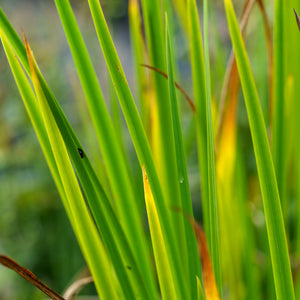The Iris Guide
Iris is a diverse and stately genus of flowering perennials known for their elegant blooms, architectural foliage, and broad adaptability. With a vast palette of colors and forms, irises offer beauty from spring through early summer in beds, borders, and water-adjacent landscapes. Named after the Greek goddess of the rainbow, these iconic plants live up to their namesake with unmatched floral variety.
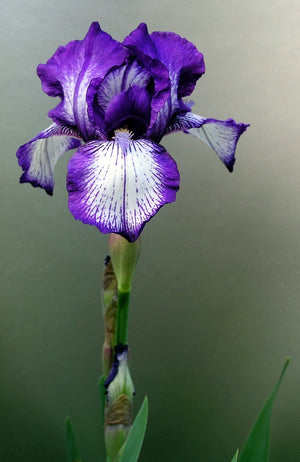
About
Iris belongs to the Iridaceae family and comprises more than 300 species, many of which are cultivated for ornamental use. The genus includes several distinct groups, each with unique growing requirements:
- Bearded Iris (Iris germanica): Recognized by their prominent “beards” on the falls (lower petals). These are sun-loving, drought-tolerant, and include popular cultivars like 'Immortality', 'Victoria Falls', 'Before The Storm', and 'Rosalie Figge'.
- Siberian Iris (Iris sibirica): Graceful, grass-like foliage and smaller flowers. Varieties like 'Caesar’s Brother', 'Swans in Flight', and 'Contrast in Styles' are staples of perennial borders.
- Japanese Iris (Iris ensata): Thrive in moisture-rich soil and produce large, flat flowers ideal for pond edges or rain gardens. Notable examples include 'Lion King', 'Harlequinesque', and 'Rose Queen'.
- Crested Iris (Iris cristata): Low-growing and ideal for woodland gardens or groundcovers. Delicate forms like 'Powder Blue Giant' and 'Tennessee White' offer early-season charm.
- Louisiana and Versicolor Irises: Wetland species like Iris versicolor 'Purple Flame' and Iris virginica are excellent for boggy or pondside conditions.
Foliage ranges from sword-like fans to arching mounds, often with striking variegation as seen in Iris pallida 'Variegata Aurea' and 'Albo Variegata'. Their ability to naturalize and return year after year makes them garden favorites across zones.
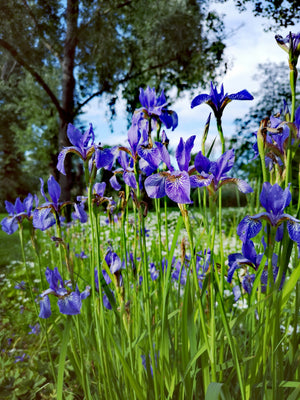
PLANTING
Iris planting success depends on selecting the correct type and providing the right environment for its specific needs:
- USDA Hardiness Zones: Most irises grow well in Zones 3–9, though Japanese and Louisiana types prefer warmer zones.
- Soil: Bearded irises need well-drained soil; Japanese irises prefer moist to wet, acidic soil; Siberian irises tolerate a wide range but do best in moderately moist, fertile soil.
- Sunlight: Full sun (6+ hours) is ideal for most irises. Some woodland species tolerate part shade.
- Spacing: Space rhizomes 12–24 inches apart, depending on type. Allow good airflow to prevent rot.
- Planting Time: Late summer to early fall (July to September) is ideal for bearded irises. Japanese and Siberian types may also be planted in spring.
When planting rhizomatous types like bearded iris, keep the top of the rhizome exposed or just barely covered to prevent rot.
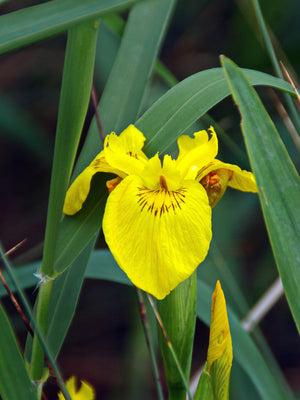
CARE
Irises are relatively low-maintenance once established, though proper care ensures longevity and bloom quality:
- Watering: Water deeply after planting. Once established, bearded irises require minimal watering, while Japanese and Louisiana irises prefer consistently moist conditions.
- Fertilizing: Apply a balanced fertilizer in early spring and again after blooming. Avoid high-nitrogen fertilizers to reduce soft growth and rot risk.
- Deadheading: Remove spent flowers to maintain appearance and redirect energy to root and rhizome development.
- Dividing: Divide every 3–5 years when clumps become crowded or flowering declines. Best done in late summer for most types.
- Cutting Back: Trim back foliage in fall to reduce overwintering pests and diseases. Leave about 6 inches of growth to protect rhizomes.
Bearded iris cultivars like 'War Chief', 'Prince of Burgundy', and 'Gnus Flash' perform best when cleaned and divided regularly to prevent rhizome rot and overcrowding.
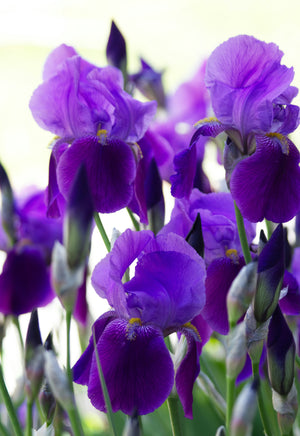
HOW TO USE
Irises are invaluable for their structure, color range, and bloom timing. They mix well into perennial gardens and can also thrive in specialty spaces:
- Mixed Borders: Bearded and Siberian irises pair beautifully with peonies, alliums, baptisia, and columbine.
- Rain Gardens and Pond Edges: Use Japanese and Louisiana types like 'Mt. Fuji' or 'Sensation' to stabilize and accentuate water features.
- Cottage Gardens: Include fragrant types such as 'Clarence' or 'Earl of Essex' in informal arrangements.
- Wildlife Gardens: Iris versicolor and Iris virginica attract native pollinators and provide food and cover for beneficial insects.
- Formal Groupings: Plant in drifts or symmetrical patterns to highlight their upright habit and vibrant blooms.
For added foliage interest, variegated selections like 'Gracieuse' and 'Albo Variegata' remain striking long after flowers fade.
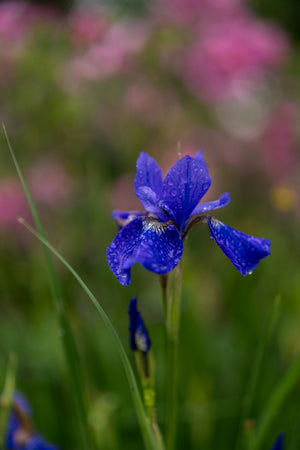
COMMON QUESTIONS
- When to plant iris bulbs? Late summer to early fall is ideal for planting rhizomatous irises. Bulbous types like dwarf iris can be planted in fall.
- When to transplant iris? Divide and transplant every 3–5 years, preferably in late summer after flowering.
- How to plant iris? Plant rhizomes with the top exposed or just under the surface. Space well and ensure good drainage.
- Do deer eat iris? Irises are generally deer resistant, though young shoots may occasionally be nibbled.
- Are iris toxic to dogs? Yes, iris rhizomes and leaves are toxic if ingested and can cause vomiting or drooling.
- Are iris toxic to cats? Yes, ingestion can result in gastrointestinal distress, so plant out of reach of curious pets.
- How to care for iris plants? Provide proper sunlight, water based on type, deadhead blooms, divide regularly, and watch for soft rot and leaf spot.
- Are iris annuals or perennials? Irises are perennials and will return year after year with proper care and division.
Conclusion
Irises are timeless garden staples that combine stately structure, brilliant color, and strong seasonal performance. With varieties suited for dry beds, wet margins, and shaded nooks, there's an iris for nearly every garden scenario. From the velvety richness of 'Black is Black' to the sky-hued petals of 'Sky Mirror', irises paint the landscape in layers of texture and hue. With the right planting and care, they’ll reward you with elegance season after season.
The Iris Collection
Sold Out
Sold Out
Sold Out
Sold Out
Sold Out
Sold Out


